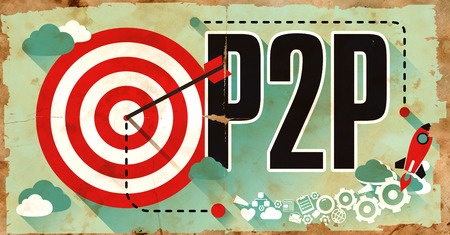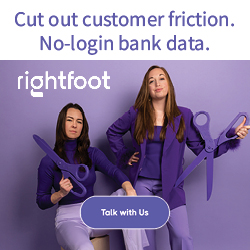Coming Soon: Domain Names as Loan Collateral
 It’s called a DeFi Cash Advance, a collateralized loan with 1-30 day terms. It’s just one of many products created by Teller, a peer-to-peer lending platform that relies on smart contracts to facilitate the transactions. The key word is “collateralized” because the blockchain-tethered asset doesn’t necessarily have to be crypto-native per se anymore. Virtually any business owner with a website can offer up its online domain name as collateral for a loan thanks to rapidly developing blockchain technology.
It’s called a DeFi Cash Advance, a collateralized loan with 1-30 day terms. It’s just one of many products created by Teller, a peer-to-peer lending platform that relies on smart contracts to facilitate the transactions. The key word is “collateralized” because the blockchain-tethered asset doesn’t necessarily have to be crypto-native per se anymore. Virtually any business owner with a website can offer up its online domain name as collateral for a loan thanks to rapidly developing blockchain technology.
“Essentially what Teller is at the core is basically like an OTC desk as a way to think about it because Teller doesn’t do any lending,” said Kieran Daniels, Growth at Teller.
Instead it’s done by peers which have historically used the platform to lend against very esoteric crypto assets that traditional commercial finance folks would probably roll their eyes at. But all that’s poised to change ever since a Silicon Valley-based startup called Namefi recently found a way to bridge regular old internet domain names to the ethereum blockchain. Namefi’s tech can turn any .com or similar internet domain into a real life NFT without any disruption to the underlying website it hosts. And once ownership of the domain name is governed by whomever owns the NFT, then voilà, it can be offered up as collateral for a loan on the blockchain.
The advantage of doing something this way is the efficiency in which it transforms a widely recognized digital asset, a domain name, into a liquid piece of collateral for a loan. For example, a loan can be made instantly just with a smart contract, it can be transferred to escrow (while still working the whole time) instantly, and also transferred to the lender in the instance of a default without any headache or hassle. The hard part, if one could even consider it hard, is that in order for the domain name to turn into an NFT, it has to be transferred from the owner’s current domain name registrar to the one operated by Namefi. This can be accomplished in less than an hour. It’s the exact same process as if one were to transfer a domain name from say Godaddy to Namecheap. Namefi does all the techy stuff that turns it into an NFT and the user can still manage their regular DNS settings via Namefi.
As mentioned previously, Teller is accustomed to other assets on its platform, things like “meme coins” and digital artwork, some of which use a technological token standard called ERC-721. That’s kind of where I ironically enter the story because I noticed that Namefi relied on the same standard when turning domain names into NFTs. And so without informing either Namefi or Teller of what I was up to, I turned a domain name that I owned into an NFT via Namefi and then used the Teller platform to set up and execute a loan transaction, resulting in a self-aggrandizing press release this past January about how smart I was for possibly doing the first domain name loan over ethereum in the world.
It was noticed. The outcome is that Namefi and Teller have been talking to each other since. On February 28, the two took to social media to announce a partnership.
Namefi is partnering with Teller (@useteller) to bring DeFi to your internet domains! Now lending with Namefi domains as collateral is made easy through this partnership.
As a result of the partnership, customers will be able to:
1. List DNS names gaslessly for liquidity: List… pic.twitter.com/nHJpkUKeXj
— Namefi.io 🍊 (@namefi_io) February 28, 2024
“We’re fully leaning into it,” said Daniels to deBanked, “we did a spaces [on X] with Namefi.”
“I think we’re just really bridging that gap for a lot of people right now and actually making that connection to say that ‘hey, NFTs aren’t just JPEGs, they aren’t just digital identity, they can have other forms of utility,'” said Alexander Walker, Ambassador at Namefi. “And there’s millions of people out there with domain names already.”
And that’s sort of the point. Everyone already understands domain names as a digital asset. The tech has just finally caught up to do that much more with them.
The typical challenge of any upstart peer-to-peer lending platform, however, is liquidity. As some readers may recall in the very early years of LendingClub and Prosper, hopeful borrowers would languish on those platforms while they waited for individual retail investors to pool together enough money to actually fund the full value of the loans. Teller has already come up with a solution for other assets it understands well, standing liquidity pools funded by peers or investors that will automatically lend against assets it recognizes. There would be a similar goal with certain categories of domain names.
“When you go to Teller, you’ll see Pokemon on ENS or 999s or certain collections of NFTs,” said Daniels of Teller. “So those are the more popular NFTs and so what Teller has done is created standing offers for those. So again, Teller isn’t the LP, but LPs can come in and add to that pool. And anyone with one of those categories can instantly get a loan or instantly borrow against that.”
 Enter .coms into the fray.
Enter .coms into the fray.
“The bigger vision is right now when you go to Teller you see Tokens, NFTs, and ENS,” Daniels said. “We want to change that to Tokens, NFTs, and Domains. […] Once we integrate that and once we get set up, then we can really lean into it and grow it from there.”
The market is still mostly unaware that this technology is here. Early interest seems to be coming from domain name investors in particular, those that think about the standalone speculative or resale value of a domain name independent of any active business use. Valuations on that basis might be too small or risky for a commercial lender to get excited about. The real opportunity then perhaps is domain names that are actively in use where the corresponding website is driving revenue for a business or even generating it on site. In the digital era, it’d be reasonable to say that many businesses depend on their web traffic to generate hundreds of thousands or millions of dollars a year in annual sales. A domain name that is being used to make that all happen is theoretically worth much more than an unused clever sounding domain name. It’s also the sort of collateral that could be monetized by a lender familiar with the market of its borrower.
With 360 million domain names registered worldwide as of Q3 2023, there’s a large market at stake.
“Domains don’t have that liquidity as of yet,” said Walker of Namefi. “But we’re currently building out that infrastructure. And that’s what makes me really excited.”
Last modified: April 26, 2024Sean Murray is the President and Chief Editor of deBanked and the founder of the Broker Fair Conference. Connect with me on LinkedIn or follow me on twitter. You can view all future deBanked events here.































